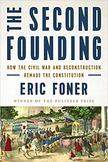Review: When a dream of equality is deferred
The word slavery appeared nowhere in the U.S. Constitution before 1865. Slavery was a matter of state and local law; not a legislative concern of the federal government. Many of our country’s founders were slave owners, including George Washington and Thomas Jefferson. It took the Civil War to eliminate slavery. Equally important, however, were three amendments to the Constitution that remade our country’s foundation: the 13th Amendment in 1865, the 14th Amendment in 1868 and the 15th Amendment in 1870. While a story about these three amendments should promise an uplifting experience, the reality is much more complicated.
Eric Foner’s The Second Founding: How the Civil War and Reconstruction Remade the Constitution, tells a sad story: how the U.S. Supreme Court, many Southern states and Congress delayed for nearly a century what Foner calls the Second Founding. Foner, an emeritus historian of the Civil War and Reconstruction at Columbia University, applauds the ideals of the supporters (the Second Founders) of the 13th, 14th and 15th Amendments. He also clearly shows that the issues debated during Reconstruction are still being examined today—the meaning of equal protection, entitlement to citizenship, the balance of powers between the federal government and the states, the right to vote and the rights of aliens.
Foner lays out in three chapters the background of each of the three amendments, provocatively titling the one section on the 13th Amendment, “What Is Freedom?” The amendment, declaring four million slaves to be free upon its ratification in 1865, introduced the word slavery into the Constitution and gave the federal government broad authority over state and local governments, businesses and private individuals to enforce its abolition.
While the first 12 amendments to the Constitution were put in place to restrain Congress (e.g., no laws limiting free speech, no cruel and unusual punishments), the second section of the 13th Amendment expanded Congress’s powers to enforce provisions to abolish slavery. But it did not address the meaning of equality before the law during a period when most people believed that the amendment would not lead to giving black males the right to vote.
Eric Foner: “To this day, persons convicted of crimes are routinely subjected to involuntary servitude while incarcerated.”
Further, under Reconstruction, a number of laws enacted across the American South undermined the 13th Amendment by allowing for involuntary black labor, particularly in the case of criminals. Foner points out that “[t]o this day, persons convicted of crimes are routinely subjected to involuntary servitude while incarcerated.” Former prisoners, after having served their penalty, are still subjected to discrimination in employment, housing, reception of food stamps and the right to vote. Florida and Kentucky, for example, only recently restored voting rights to more than a million ex-felons in 2018 and 2019.
In his examination of the 14th Amendment, Foner notes that “no change in the Constitution since the Bill of Rights has had so profound an impact on American life.” Unlike the 13th Amendment, which had no “state action” requirement and applied to both public authorities and private parties, the 14th Amendment affected only actions by the state or local governments, mandating equal protection under the law.
The history of the times can be understood by looking at the Civil Rights Act of 1866. The act outlawed private practices that would exclude blacks from hotels, some modes of transportation and other public venues. Democrats opposed the Civil Rights Act because it could lead to black suffrage, integrated public schools, interracial marriage and other so-called evils. As a result, President Andrew Johnson vetoed the Civil Rights Act, but it became law over his veto.
The Supreme Court’s infamous opinions on the 14th Amendment developed for over a century after its passing. The court ruled that segregation was not unconstitutional provided that the separate accommodations were “of equal merit” and the activities involved private businesses, not state or local bodies. It also ruled that the “egregious violations” in the age of Jim Crow and, later, the internment of Japanese-Americans in World War II, were constitutional.
Another interpretation of the 14th Amendment’s equal protection provision occurred just recently, in a 2019 Supreme Court opinion on racial discrimination in jury selection. In that case the state prosecutor employed peremptory challenges to strike 41 out of 42 black prospective jurors; the almost all-white jury then convicted the defendant of murder. The Supreme Court reversed the convictions, with Justice Kavanaugh acknowledging the history of racial discrimination in jury selection and the 14th Amendment’s original objective to protect black people’s right to jury service. One of the striking elements in this case is that the U.S. Supreme Court’s action reversed the Mississippi Supreme Court’s decision upholding the convictions.
Regarding the 15th Amendment, Foner notes that it was passed just two years after “[t]he future of black suffrage became a major issue in the presidential campaign of 1868.” The Democratic vice presidential candidate that year claimed that Reconstruction put the South under the rule of “an alien race of semi-barbarous men.” Various efforts were in place to deny the right to vote to black men, including requirements like property ownership, literacy tests and poll taxes.
Any study of legal opinions from Reconstruction through the end of the 19th century must, regrettably, include a list of infamous decisions by the U.S. Supreme Court.
With the historical background on the three Reconstruction Amendments covered, Foner analyzes the Supreme Court’s “crucial role in the long retreat from the ideals of Reconstruction.” He notes that on issues like the relationship between the federal government and state power, the meaning of “equal protection,” and the legality of segregation, “in almost every instance, the [Supreme] Court chose to restrict the scope of the second founding.”
Any study of legal opinions from Reconstruction through the end of the 19th century must, regrettably, include a list of infamous decisions by the U.S. Supreme Court. The court denied suffrage for women (1873), held that the Civil Rights Acts of 1875 were unconstitutional because they covered acts by private parties (1883) and upheld separate accommodations at hotels and theaters and racial segregation in public schools so long as the facilities were “of equal merit” (1877 and 1896).
State legislatures and white voters come off no better in this account. An “Appendix on Reconstruction” from 1865 to 1877 describes in detail numerous setbacks for African-Americans after the heady first few years after the Civil War. For example, in 1870 and 1875, the first and second African-American senators in U.S. history were elected. The next African-American was elected to the Senate almost a century later, in 1967. In 1872, the first African-American governor was elected. The next was not elected until 1989.
Significant revisions occurred during the 1950s and 1960s, but deep inequalities remain today. In an epilogue, Foner summarizes the shortcomings of the Reconstruction Amendments as interpreted by the Supreme Court, and offers several potential changes to the court’s narrow interpretation of these amendments to give new meanings based on their language and intent.
Whether one agrees with all of Foner’s interpretations and suggestions or not, The Second Founding: How the Civil War and Reconstruction Remade the Constitution presents his arguments in an intelligent manner with a strong historical foundation. His positions should earn the readers’ attention as they wrestle with the best approach needed to bring justice to the public square.
This article also appeared in print, under the headline “A dream deferred,” in the June 22, 2020, issue.











